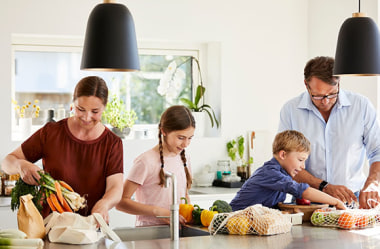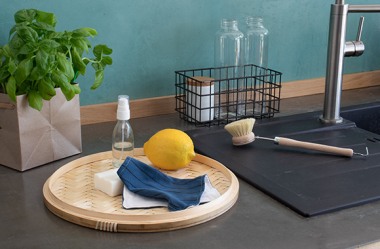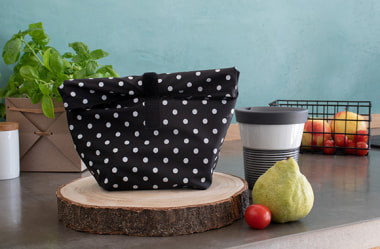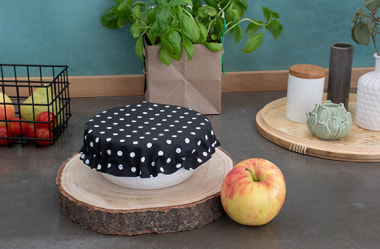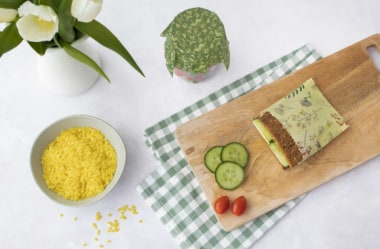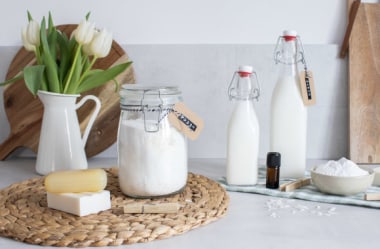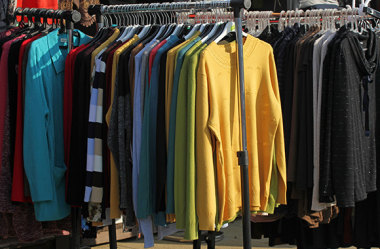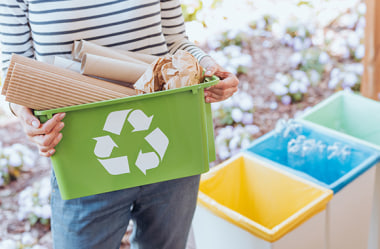Zero Waste Guide – living more sustainably
Whilst shopping for food or clothes, cooking, working or pursuing a hobby – in the EU each person on average produces around 505 kilograms of waste per year. That is well over 1 kilo per day. Although most countries in Europe separate rubbish, only a small proportion is actually recycled and reused. Most of the waste ends up in landfill sites or is incinerated. The impact on the environment is enormous and as environmental awareness grows among the population, so does the drive for change.
How does zero waste work?
The zero waste movement is a new approach with a new way of thinking. People who live by the zero waste principles try to avoid waste wherever possible. The thought of eliminating waste sounds almost impossible, as neither our society nor the industries are prepared for it. Terms such as ‘low waste’ or ‘less waste’ are easier to imagine and have been proved successful. The goal should be to send no waste or as little as possible to landfills. The zero waste lifestyle is based on five simple principles:
- Avoid: If you don’t need something, then you should do without it. Self-control plays an important role, but critical thinking is just as important. For example, think about how many things you have at home or perhaps which things could you share with family, friends or neighbours.
- Reduce: Consuming less means throwing less away. This does not only refer to material things, but electricity, water consumption and using your car also fall into this category.
- Reuse: Many items have a long shelf life. Proper use and looking after your things helps to make them to last longer! Repairing things or lending them to someone in your local community or giving them to someone who can still use them is a great way to extend their shelf life and to avoid any waste.
- Recycle: Valuable raw materials can sometimes be recovered from waste. Waste should be separated properly. An even better option would be upcycling, which can turn old unwanted products into new and useful products!
- Compost: Waste that cannot be reused is sometimes compostable. This means that it decomposes over time and goes back to the first stage of the natural cycle.
How zero waste started
The Frenchwoman Beá Johnson, who lives with her family in the USA, is considered the founder of this movement. She has been living nearly waste-free since 2008 and has a blog on the topic. She has also written a book about zero waste. The Johnson family only produce enough waste per year to fill a large jar. This has been made possible by adapting the zero waste method. Johnson believes that many people are put off as it can seem a bit overwhelming to follow a zero waste lifestyle, but this is still unproven. It is both sustainable and a great option to make as much homemade food as possible, but Johnson emphasises that this is difficult for many people, especially families. It’s easier to buy non packaged and unprocessed (reusable) products whenever possible. You will save time and money, while also protecting the environment and maintaining good health.
Each person consumes up to 70,000 pieces of microplastic per year. It’s possible to reduce this figure by avoiding plastic waste and plastic packaging.
Each person consumes up to 70,000 pieces of microplastic per year. It’s possible to reduce this figure by avoiding plastic waste and plastic packaging.
The aim of the Zero Waste Movement
The goal of the Zero Waste Movement is to evolve as a society towards a circular economy. Currently, our economy is linear, which means raw materials are processed into products, which are used and then thrown away. These raw materials do not go back to the first stage of the natural cycle. They end up as waste in landfills sites, polluting our environment and affecting our climate. In a circular economy, raw materials are used in such a way that they become part of the natural cycle at the end of their life cycle. This method will help to conserve the earth’s natural resources. Read the article on Cradle to Cradle to learn more about a circular economy.
The Zero Waste Movement aims to reduce waste and to change the way society thinks. The changes start at home! Evaluating your own consumption is the first step. We are not always aware of how often and how much waste we produce each day. This guide is intended to help you get started and to provide some ideas on when and where you can avoid waste in your daily life. The mottoes are ‘reusable instead of disposable’ and ‘do-it-yourself instead of buying something new’. Making simple homemade products with a couple of tips and tricks is an easy way to avoid a lot of packaging waste in everyday life, which protects our environment and helps you to save money.
All Articles
Zero Waste – reducing waste in everyday life
Avoiding products in packaging and making your daily life more sustainable is becoming increasingly important to a lot of people. The average person produces quite a bit of waste throughout the day. It is estimated that a person will produce more than a kilogram a day. There are many ways in which you can be more environmentally friendly, which is not only good for the environment, but also for your health. You don’t need to completely change your life. We’ll show you how you can easily and simply avoid packaging in your daily life and take a step towards achieving a zero waste lifestyle.
The production of single-use plastic products, such as straws or to-go cups, have been banned in the EU since 3rd July 2021. This decision from the EU member states is an important step towards a circular economy!
The production of single-use plastic products, such as straws or to-go cups, have been banned in the EU since 3rd July 2021. This decision from the EU member states is an important step towards a circular economy!
Upcycling clothing – practical and reusable DIY cloths
Large amounts of waste are generated every day, especially in the bathroom and kitchen. Makeup remover wipes or paper towels are usually thrown away after just one use. However, there is a sustainable and simpler solution by using old clothes to make your own washable makeup remover pads or reusable kitchen towels. After use, simply put them in the washing machine. This upcycling guide includes information on the properties of fabrics, as well as a clear step-by-step sewing guide. With just a few simple steps, you can already start to live a sustainable lifestyle.
DIY lunch bag: upcycling an old raincoat
Our everyday lives are dominated by disposable products. Whether it's kitchen roll or cotton pads, most of it ends up in the bin after just one single use. Upcycling is a sustainable and environmentally friendly solution to this problem, which adopts the method of making something new out of something old! Zero waste means not throwing away what is no longer needed. An old raincoat, for example can be sewn into a reusable lunch bag in just a few simple steps! The raincoat won’t end up on a landfill site and you will then have a unique small bag for on-the-go.
Kitchen upcycling: make your own bowl covers
A lot of rubbish is generated every day, especially in the kitchen. Cling film and aluminium foil usually end up in the bin after just one single use. They are also known to give off microplastic and harmful substances, which can then go onto your food. Yet, many disposable products in the kitchen can easily be avoided because you can cover bowls and pots perfectly with homemade covers. To make your kitchen more sustainable and to produce less waste all you need is a few old clothes, a raincoat and a sewing kit. Following the step-by-step upcycling guide on turning your old raincoat into a bowl cover will help to bring you one step closer to living a sustainable lifestyle.
Cut down on rubbish by making your own beeswax wraps: follow our step-by-step guide
Beeswax wraps are another environmentally friendly alternative to gradually banish cling film and aluminium foil from your kitchen. You can use beeswax wraps to wrap up food as well as for covering food. In our easy step-by-step guide, we will show you how to make your own beeswax wraps. All you need are some old clothes made out of natural fibres such as organic cotton, some oil and beeswax.
The homemade beeswax wraps are reusable. We will show you how to use them so that they last longer and we will also give you some tips on how to keep them clean and in good condition. By using homemade beeswax wraps you help to cut down on packaging waste and take an important step towards a zero-waste lifestyle.
Follow our step-by-step guide on how to make your own washing to detergent to help to protect the environment
An environmentally friendly approach to clothing includes looking after your clothes so that you can get the most out of them. This is especially important when it comes to washing your clothes. In addition, there is a large selection of conventional detergents available on the market. One of the disadvantages of purchasing such products is that they produce more waste due to their packaging.
You can help to cut down on waste being produced by taking another step towards a zero waste lifestyle and making your own detergent. We will give you some handy tips on how you can replace conventional detergents with a homemade detergent. In our step-by-step guide, we will show you how to make your own washing powder and liquid detergent with just a couple of simple everyday products.
Clothing donations
On average, each item of clothing lasts between 3 and 5 years before they are sorted out and replaced. After sorting out old clothes, they can be donated to various organisations either via post, clothing banks or charity events. At a lot of charity events many items of clothing are given a new life. This article gives you an insight into how clothing donation charities operate in Europe.
Cradle-to-Cradle
Cradle-to-Cradle is the name of an economic approach that aims to achieve a full circular economy. Most materials and products end up in the bin after just one single use and they are either incinerated or end up at a landfill site. A product’s shelf life can last several years or just a few minutes. The cradle-to-cradle method, reusability and recyclability are used throughout the whole process from designing to producing the product. The production should be seen as part of the circle so that each component of a product can be recycled. This article explains what Cradle-to-Cradle means, how it can be implemented and where it has already been implemented.
Join a library! You will have access to a huge selection of books any time you need them without having to buy any. You can try and borrow many other things instead of buying them. At a lot of DIY centres, you can rent a drill or other tools for a few hours or several days.
Join a library! You will have access to a huge selection of books any time you need them without having to buy any. You can try and borrow many other things instead of buying them. At a lot of DIY centres, you can rent a drill or other tools for a few hours or several days.
Conclusion
The topics of sustainability and reducing waste are more popular than ever before. Every year, more than 8 million tons of waste end up in our oceans, which poisons animals and plants. Society and the government are adopting a new way of thinking. More and more people want to do their part to protect the environment and to avoid producing waste. The zero waste lifestyle offers many useful approaches to sensibly reducing or even avoiding plastic waste. Through practical upcycling projects, you can give many old clothes a new life. If you don’t need to upcycle an item of clothing, then it can be given to those in need through clothing donations. Future-oriented approaches such as Cradle-to-Cradle show that a full-circular economy is entirely possible.
However, you should try and avoid plastic packaging where possible so that you can minimise your household waste. Zero waste also means conserving resources. It’s better to use up products and then replace them with more sustainable alternatives.
References:
https://www.consumerreports.org/
(Accessed on 12.04.2022)
https://www.earthday.org/
(Accessed on 12.04.2022)
http://www.ecap.eu.com/
(Accessed on 12.04.2022)
https://ec.europa.eu/
(Accessed on 12.04.2022)
https://ec.europa.eu/
(Accessed on 12.04.2022)
https://www.globalcitizen.org/
(Accessed on 12.04.2022)
https://www.healthyandnaturalworld.com/
(Accessed on 12.04.2022)
Image sources:
iStock.com/monkeybusinessimages
iStock.com/Nomad
iStock.com/Radila Radilova
iStock.com/KatarzynaBialasiewicz

